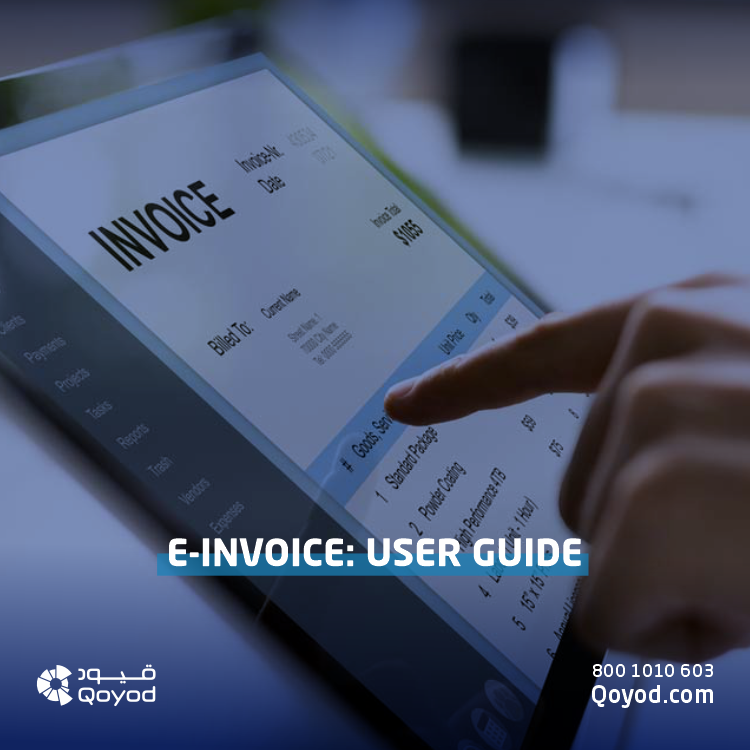An electronic invoice is an electronic document used as an account statement for goods and services purchased by customers and clients.
E-invoices are usually sent and received by email or through an online portal, and can be easily stored and accessed electronically.
Electronic invoicing is a more efficient and cost-effective alternative to traditional paper invoicing.
It eliminates the need to manually print, send mail and enter data into accounting systems.
Electronic invoicing also improves the accuracy of invoices and payments, and makes compliance with tax and regulatory requirements easier.
In this article, we will talk about the electronic invoice and the way electronic invoicing works.
And its importance in the field of accounting, and we take a quick look at the electronic invoice issued by the Zakat, Tax and Customs Authority, which was called the Zakat and Income Authority in the Kingdom of Saudi Arabia.
What is e-invoicing?
Electronic invoicing is the process of creating, sending, receiving, and processing invoices in electronic format through a structured and predefined data exchange process.
This typically involves using computer, the Internet, and specialized software to create, send, and manage invoices.
This electronic exchange can be enabled with two main options: the first is point-to-point communication between the buyer and the seller, which often happens when using electronic exchange invoices for data.
The other option is through a network that connects multiple buyers and sellers.
Electronic invoicing replaces traditional paper invoicing methods and enables businesses to streamline invoicing and payment processes.
Electronic invoicing typically includes features such as automatic data entry, real-time tracking, and electronic payment options, which can improve the speed, accuracy, and efficiency of invoices and payments.
What information is included in e-invoices?
Electronic invoices include the following information:
- Invoice number: A unique identifier for the invoice.
- Date: The date the invoice was issued.
- Customer Information: The name, address and contact information of the person or company to which the invoice will be sent.
- Product or service details: A description of the goods or services being billed, including quantity and price.
- Tax information: Here the taxes due, such as sales taxes or VAT, and the amount of each tax are mentioned.
- Total amount due: It is the total amount due to the invoice, including taxes.
- Payment Terms: Information on when and how the invoice is paid, such as due date, payment methods, and any discounts or fines on late payments.
- Reference information: Here any relevant reference numbers, such as purchase order numbers or contract numbers, are mentioned.
- Additional information: Usually other relevant information such as shipping address and transfer address and the person responsible for the bill.
The specific information included in e-invoices can vary depending on the nature of the transaction, the type of goods or services being invoiced, and applicable laws and regulations.
What are the advantages offered by e-invoicing?
Using electronic invoices has many benefits, including:
- Cost savings: Electronic invoices reduce the costs associated with printing and mailing paper invoices, as well as reducing the costs of manual data entry into accounting systems.
This results in significant cost savings for companies, especially those that process a large amount of invoices.
- Increase efficiency: An electronic invoice automates many of the tasks associated with invoices and payments, such as data entry and invoice reconciliation, which can improve the speed and accuracy of these processes.
This helps ensure compliance with tax and regulatory requirements.
Electronic invoices can include features such as digital signatures and real-time tracking.
- Improve cash flow: Electronic invoices help speed up the payment process, as invoices can be sent and received electronically and payments can be made electronically, which helps improve the cash flow of companies.
- Increased security: Electronic invoices are often more secure than paper invoices, as they can include features such as digital signatures and encryption to protect sensitive information.
- This contributes to preventing fraud and protecting companies from financial losses.
- Improved record keeping and maintenance: Electronic invoices enable easy invoice storage and retrieval, making it easier for companies to track their financial records, improving financial reporting and identifying spending patterns.
- Reduce environmental footprint: E-invoicing reduces paper usage, which is beneficial to the environment and also reduces storage costs.
- Improved collaboration: E-invoicing provides better collaboration between the buyer and supplier, as all relevant information is easily accessible and tracked in real time.
- Improve compliance with legislation and regulations: Electronic invoices help comply with various tax and regulatory requirements.
What are the stages of applying the e-invoice in Saudi Arabia?
The Zakat, Tax and Customs Authority, which was called the Zakat Authority, announced the existence of two phases for the application of the electronic invoice in the Kingdom, namely:
First stage
The implementation of this phase began on December 4, 2021.
This stage requires taxpayers to issue and store invoices electronically in an electronic billing system that meets the requirements approved by the Authority.
Second stage
The Authority announced that the implementation of the second phase of the electronic invoice will be on January 1, 2023 in a phased manner.
This phase is known as “integrated connectivity” and is an extension of the first phase.
At this stage, electronic invoicing systems must be linked to the system of the Zakat, Tax and Customs Authority through the (Fatora) platform, which was called the Zakat Authority.
The purpose is to facilitate the circulation of data, approve invoices and taxes, and ensure that their data is correct.
The conclusion
After we talked in this article about the electronic invoice, explained its features and mentioned the stages of applying electronic invoicing in the Kingdom, we must mention at the end of this article the advantages that Qoyod will offer you in this regard.
Qoyod program offers its customers many features related to electronic invoicing in Saudi Arabia, which include, for example, activating the electronic invoice feature from the system settings, and issuing electronic invoices according to the items set by the Zakat, Tax and Customs Authority, which was called the Zakat and Income Authority.
All you need is a click of a button to connect and activate with Qoyod at no extra charge.




